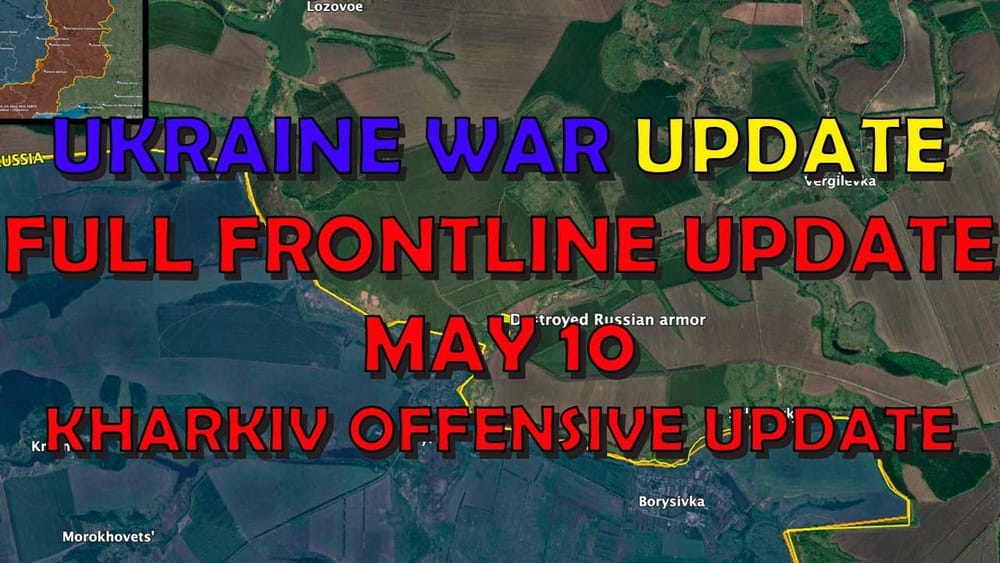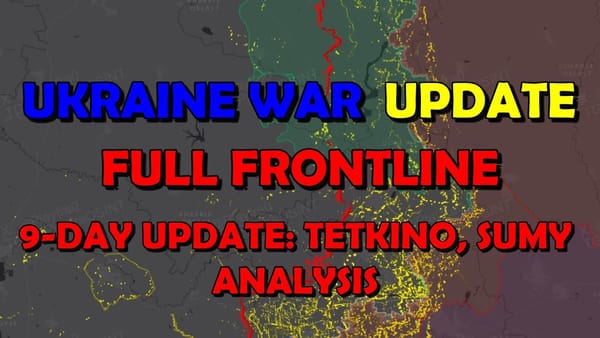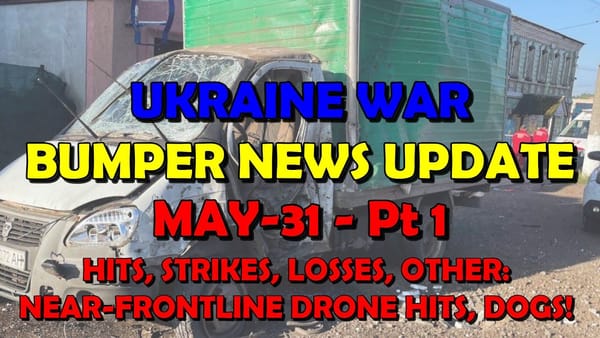Ukraine Conflict: Full Frontline Update, Kharkiv Offensive Update
🤖
This summary has been produced automatically by an AI Large Language Model (LLM) without any human intervention. Whilst every effort has been made to prompt the LLM to produce accurate output, there may be inconsistencies, inaccuracies or hallucinations!
"I just i just yeah i don't know i don't want to stop the russians from making bad decisions"
10/05/2024
Hello Team00:00-00:24⏩Jonathan welcomes viewers to the daily frontline update, reminding them about the map key and the recent breaking news update regarding the Kharkiv offensive.
Return to top⤴️
Initial Reports and Analysis of the Kharkiv Offensive00:24-03:38⏩
- Initial reports from Deep State Maps suggested significant Russian territorial gains in the Kharkiv Oblast, but these are now considered inaccurate.
- President Zelensky confirmed a Russian offensive in the region.
- Jonathan and analysts agree that a full-scale assault on Kharkiv city is unlikely due to insufficient Russian troop numbers (estimated at 50,000). Capturing a city of Kharkiv’s size and defences would require significantly more manpower.
- The offensive is likely intended to fix Ukrainian forces, diverting them from other areas like Donetsk.
Return to top⤴️
The Strategy of Fixing and Attrition: Lessons from Krynky03:38-07:19⏩Jonathan draws a parallel between the Kharkiv offensive and the ongoing situation in Krynky:
- In Krynky, a small Ukrainian bridgehead is effectively fixing a much larger Russian force, causing disproportionate losses through attrition.
- Jonathan estimates that a small number of Ukrainian troops (perhaps 100) are tying down a much larger Russian contingent, demonstrating the effectiveness of this strategy.
- He questions whether a similar strategy is at play in Kharkiv, arguing that unless the Russians commit a significant portion of their 50,000 troops, the diversionary effect will be minimal.
- Ukraine could readily reinforce the region with units currently defending Kyiv or from newly formed brigades.
Return to top⤴️
ISW Assessment of Russian Objectives in Kharkiv07:19-10:13⏩Jonathan outlines the ISW's assessment of Russian objectives:
- Fixing Ukrainian Forces: Stretching Ukrainian defences across the 600-mile frontline and creating vulnerabilities elsewhere, particularly in Donetsk.
- Drawing Ukrainian Forces towards Vovchansk: This would support Russia's stalled efforts to capture the strategically important Kupyansk.
- Creating a Demilitarized Zone: Establishing a buffer zone within Ukrainian territory.
- Sowing Panic and Undermining Morale: Pressuring the Ukrainian government and population.
- Setting the Stage for a Larger Offensive: Potentially laying the groundwork for a future attack on Kharkiv.
Return to top⤴️
Jonathan's Critique of Russian Strategy10:13-11:04⏩Jonathan questions the logic of the offensive, particularly the limited scale of the attack:
- The ISW highlights the narrow front of the Russian advance, suggesting a lack of commitment to a serious push towards Kharkiv city.
- Observed Russian losses (five vehicles) are inconsistent with a major offensive.
- Jonathan argues that if the Russians were truly committed to capturing key objectives like Kupyansk or Krasnohorivka, they would be better served by concentrating their forces in those areas rather than dispersing them in a diversionary attack.
Return to top⤴️
The Urgent Need for Enhanced Ukrainian Air Defence11:04-12:05⏩
- The offensive highlights Ukraine’s vulnerability to attacks launched from within Russian airspace.
- Jonathan reiterates the need for the US to provide Ukraine with more long-range air defence systems, ideally those capable of intercepting Russian aircraft within Russian territory.
- He believes that this capability, which Ukraine may have already demonstrated in a previous incident in Bryansk, is crucial for effectively defending Kharkiv and other border regions.
Return to top⤴️
Russian Losses Near Pilna: Evidence and Analysis12:05-13:52⏩
- Initial reports placed destroyed Russian vehicles within Kharkiv, but updated geolocation by Tendar indicates they were struck inside the Belgorod region of Russia, before crossing the border.
- Jonathan notes that this is to be expected: Ukrainian forces, using effective intelligence and surveillance, would seek to neutralise Russian units before they can establish a foothold within Ukrainian territory.
- He emphasises that the small size of the Russian units (characterised as “deep reconnaissance groups”) makes them particularly vulnerable to this kind of preemptive strike.
Return to top⤴️
Further Analysis of the Kharkiv Incursion: Expert Opinions13:52-18:53⏩
- Jonathan reviews assessments from various military analysts:
- Rob Lee: Highlights Russia's aim of drawing Ukrainian reserves away from critical areas in Donetsk, emphasising Ukrainian manpower constraints as a key vulnerability.
- Tatar-Grami: Notes the strategic logic of Russia's approach, exploiting the grey zone nature of the border and Ukraine's inability to heavily fortify the entire frontier due to manpower shortages.
- Frontline Intelligence Insights: Echoes this assessment, predicting further Russian attempts to exploit weaknesses along the border.
- Jonathan provides context from his own experiences visiting the Sumy Oblast, explaining the rationale behind Ukraine’s defensive posture:
- Fortifications are generally positioned further back from the border to avoid constant exposure to Russian artillery and drone attacks.
- The area immediately along the border is treated as a grey zone, with Ukrainian forces relying on mobile defence and preemptive strikes rather than fixed positions.
Return to top⤴️
Zelensky’s Response and Ukrainian Troop Deployments18:53-19:44⏩
- Zelensky confirms that Ukraine is deploying additional troops to the Kharkiv sector in response to the Russian offensive.
- He remains confident in Ukraine's ability to repel the attack and disrupt any further Russian advances.
- The Deputy Commander of the 3rd Special Brigade suggests that Russia has not yet committed its main forces, viewing the current operations as probing attacks to test Ukrainian defences.
Return to top⤴️
Jonathan's Conversations with Ukrainian Contacts and Observations on Belgorod19:47-21:07⏩
- Jonathan shares a conversation with a Ukrainian contact (“Zhenya”), who seemed unconcerned about the situation in Kharkiv, suggesting that Ukrainian forces were well-prepared.
- He notes explosions reported in Belgorod, speculating that this could indicate Ukrainian retaliatory strikes.
Return to top⤴️
Ukrainian ATACMS Strike on Oil Depot in Rovenki21:07-22:44⏩
- Jonathan reports a successful Ukrainian ATACMS strike on an oil depot in Rovenki, within Russian-occupied Luhansk.
- He provides details about the location and range of the strike (approximately 150km), suggesting it was likely carried out by a HIMARS system.
- He confirms that the US has authorised the use of ATACMS for targets within occupied territory.
Return to top⤴️
Frontline Update: Luhansk and Donetsk22:47-25:15⏩Jonathan provides a brief update on other areas of the frontline:
- Luhansk Oblast: Russian assaults near Nevska have been unsuccessful.
- Kupyansk, Svatove, Kreminna, Sversk, Chasiv Yar, Northern Avdiivka: No significant changes in the last 24 hours.
- Pervomayske: As anticipated, Russian forces have made gains, operationally encircling Ukrainian positions northeast of Novomykolaivka.
- Krasnohorivka: Syriac Maps reports significant Russian advances, with Ukrainian positions under increasing pressure.
Return to top⤴️
Jonathan's Analysis of the Overall Situation and Potential for Russian Culmination25:15-28:53⏩Jonathan reflects on the day’s events, pondering the strategic implications of the Kharkiv offensive:
- He questions whether the offensive is a wise use of Russian resources, particularly if the wider frontline is indeed reaching a point of culmination.
- He notes the reported high Russian casualties (over 1,000 per day) and the increasing effectiveness of Ukrainian artillery, including cluster munitions.
- He remains uncertain about the ultimate objectives and potential success of the Kharkiv offensive, acknowledging the possibility that he is being overly optimistic.
- He concludes by highlighting the critical importance of air defence in this sector, urging viewers to share their thoughts.
Return to top⤴️
Wrap Up28:53-28:58⏩Jonathan thanks viewers and signs off.
Return to top⤴️
AI Queries
In the section on the ATACMS strike (21:07 - 22:44), Jonathan refers to a location called “ravenki” when discussing the oil depot. Based on the context and map coordinates provided, it seems this should be "Rovenki." I have used the correct spelling of "Rovenki" in the summaries. Please could you confirm if this is correct?
It was difficult to follow the analysis of troop numbers and their potential impact on various fronts without a clear understanding of the force ratios required for successful offensive or defensive operations. Any additional insights you could provide on this would be helpful.
AI Step by Step Thought Process
This is a frontline update video, focusing on the Kharkiv offensive. I will need to:
Extract the title, date, and part from the Youtube title.
Divide the transcript into topics based on location and subject matter. Jonathan jumps around a lot in this one, but I'll try to maintain a clear, logical structure.
Assign specific, quantified titles to each topic. For example, "Russian Losses near Pilna" is much better than "Kharkiv Offensive Update."
Record accurate timeframes for each topic.
Summarise the key points of each section, including Jonathan's opinions and analysis.
Select a compelling quote that encapsulates the essence of the video.
Highlight any parts of the transcript I found unclear in the `AI Queries` section.



